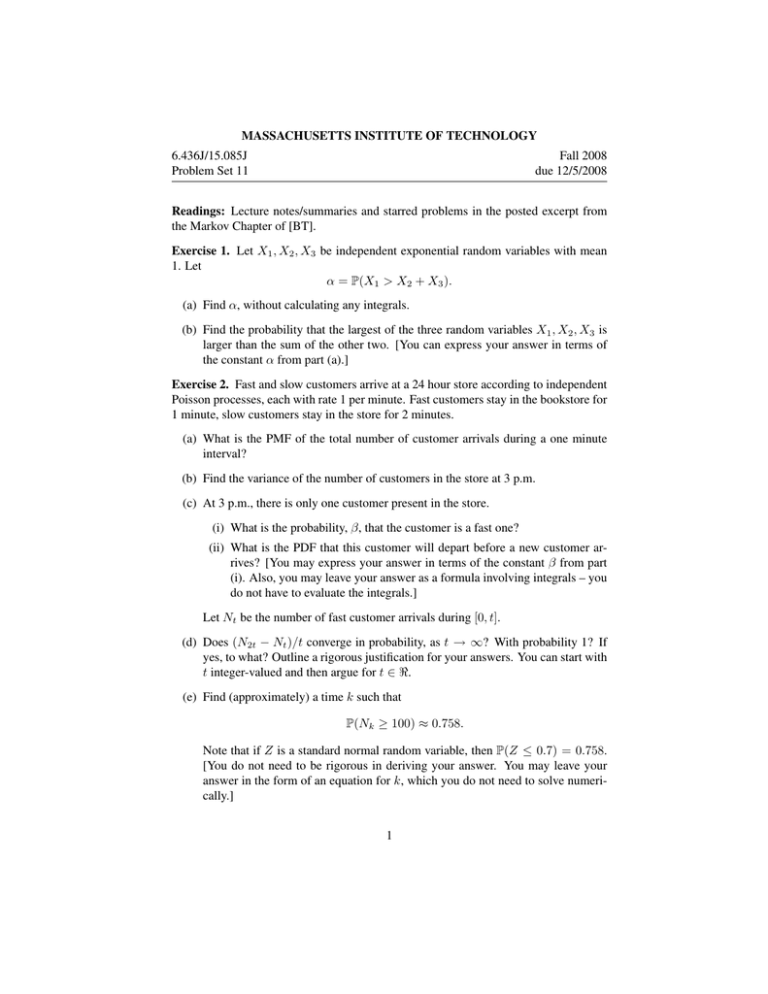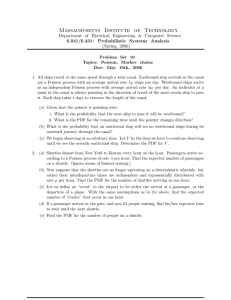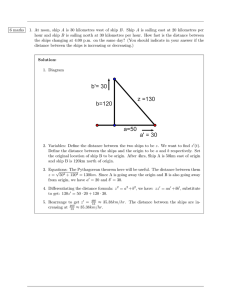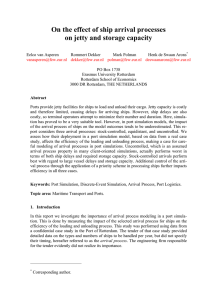MASSACHUSETTS INSTITUTE OF TECHNOLOGY 6.436J/15.085J Fall 2008 Problem Set 11
advertisement

MASSACHUSETTS INSTITUTE OF TECHNOLOGY
6.436J/15.085J
Problem Set 11
Fall 2008
due 12/5/2008
Readings: Lecture notes/summaries and starred problems in the posted excerpt from
the Markov Chapter of [BT].
Exercise 1. Let X1 , X2 , X3 be independent exponential random variables with mean
1. Let
α = P(X1 > X2 + X3 ).
(a) Find α, without calculating any integrals.
(b) Find the probability that the largest of the three random variables X1 , X2 , X3 is
larger than the sum of the other two. [You can express your answer in terms of
the constant α from part (a).]
Exercise 2. Fast and slow customers arrive at a 24 hour store according to independent
Poisson processes, each with rate 1 per minute. Fast customers stay in the bookstore for
1 minute, slow customers stay in the store for 2 minutes.
(a) What is the PMF of the total number of customer arrivals during a one minute
interval?
(b) Find the variance of the number of customers in the store at 3 p.m.
(c) At 3 p.m., there is only one customer present in the store.
(i) What is the probability, β, that the customer is a fast one?
(ii) What is the PDF that this customer will depart before a new customer ar­
rives? [You may express your answer in terms of the constant β from part
(i). Also, you may leave your answer as a formula involving integrals – you
do not have to evaluate the integrals.]
Let Nt be the number of fast customer arrivals during [0, t].
(d) Does (N2t − Nt )/t converge in probability, as t → ∞? With probability 1? If
yes, to what? Outline a rigorous justification for your answers. You can start with
t integer-valued and then argue for t ∈ �.
(e) Find (approximately) a time k such that
P(Nk ≥ 100) ≈ 0.758.
Note that if Z is a standard normal random variable, then P(Z ≤ 0.7) = 0.758.
[You do not need to be rigorous in deriving your answer. You may leave your
answer in the form of an equation for k, which you do not need to solve numeri­
cally.]
1
Exercise 3. All ships travel at the same speed through a wide canal. Eastbound ships
arrive as a Poisson process with an arrival rate of λE ships per day. Westbound ships
arrive as an independent Poisson process with an arrival rate of λW ships per day. An
indicator at a point in the canal is always pointing in the direction of travel of the most
recent ship to pass. Each ship takes t days to traverse the canal.
(a) What is the probability that the next ship passing by the indicator causes it to
change its direction?
(b) What is the probability that an eastbound ship will see no westbound ships during
its eastward journey through the canal?
(c) If we begin observing at an arbitrary time, determine the probability mass func­
tion of the total number of ships we observe up to and including the seventh
eastbound ship we see.
(d) If we begin observing at an arbitrary time, determine the PDF of the time until
we see the seventh eastbound ship.
(e) Given that the pointer is pointing west:
(i) What is the probability that the next ship to pass it will be westbound?
(ii) What is the PDF of the remaining time until the pointer changes direction?
Exercise 4. Let Y be exponentially distributed with parameter λ1 . Let Zk be Erlang
of order k. with parameter λ2 . Assume that Y and Zk are independent. Let Mk =
max{Y, Zk }. Find a recursive formula for E[Mk ], in terms of E[Mk−1 ]. Hint: There is
a similar problem in [BT].
Exercise 5. Let S be the set of arrival times in a Poisson process on R (i.e., a process that
has been running forever), with rate λ. Each arrival time in S is displaced by a random
amount. The random displacement associated with each element of S is a random
variable that takes values in a finite set. We assume that the random displacements
associated with different arrivals are independent and identically distributed. Show that
the resulting process (i.e., the process whose arrival times are the displaced points) is a
Poisson process with rate λ. (We expect a proof consisting of a verbal argument, using
known properties of Poisson processes; formulas are not needed.)
Exercise 6. Consider a discrete-time, finite-state Markov chain {Xt }, with states {1, . . . , m},
and transition probabilities pij . States 1 and n are absorbing, that is, p11 = 1 and
pmm = 1. All other states are transient. Let A be the event that the state eventually
becomes 1. For any possible starting state i, let ai = P(A | X0 = i) and assume that
ai > 0 for every i �= n. Conditional on the information that event A occurs, is the
process Xn necessarily Markov? If yes, provide a proof, together with a formula for its
transition probabilities. If not, provide a counterexample.
2
MIT OpenCourseWare
http://ocw.mit.edu
6.436J / 15.085J Fundamentals of Probability
Fall 2008
For information about citing these materials or our Terms of Use, visit: http://ocw.mit.edu/terms.







